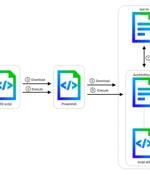Security News

Cyber attacks involving the DarkGate malware-as-a-service (MaaS) operation have shifted away from AutoIt scripts to an AutoHotkey mechanism to deliver the last stages, underscoring continued...

The North Korea-linked threat actor known as Andariel has been observed using a new Golang-based backdoor called Dora RAT in its attacks targeting educational institutes, manufacturing firms, and...

Fake web browser updates are being used to deliver remote access trojans (RATs) and information stealer malware such as BitRAT and Lumma Stealer (aka LummaC2). "Fake browser updates have been...

An international coalition of police organized by the European Union's justice and police agencies has revealed an ongoing operation against malware droppers that Europol calls the "Largest ever operation" of its kind. Called "Operation Endgame," the ongoing initiative targets malware delivery "Droppers" and "Loaders," and is an attempt to disrupt large-scale malware deployments.

Operation Endgame, announced by Europol yesterday, led to the seizure of 100 servers used in multiple malware operations, including IcedID, Pikabot, Trickbot, Bumblebee, Smokeloader, and SystemBC. The law enforcement crackdown also involved four arrests, one in Armenia and three in Ukraine. Yesterday, the Federal Criminal Police Office of Germany revealed the identities of eight cybercriminals of Russian descent, who are thought to have held central roles in the Smokeloader and Trickbot malware operations.

The Russian GRU-backed threat actor APT28 has been attributed as behind a series of campaigns targeting networks across Europe with the HeadLace malware and credential-harvesting web pages. APT28,...

Cybercriminals are distributing a malware cocktail through cracked versions of Microsoft Office promoted on torrent sites. The malware delivered to users includes remote access trojans, cryptocurrency miners, malware downloaders, proxy tools, and anti-AV programs.

A malware botnet named 'Pumpkin Eclipse' performed a mysterious destructive event in 2023 that destroyed 600,000 office/home office internet routers offline, disrupting customers' internet access. The incident had a focused impact, affecting a single internet service provider and three models of routers used by the firm: the ActionTec T3200s, ActionTec T3260s, and Sagemcom F5380.

A malware botnet named 'Pumpkin Eclipse' performed a mysterious destructive event in 2023 that destroyed 600,000 office/home office internet routers offline, disrupting customers' internet access. The incident had a focused impact, affecting a single internet service provider and three models of routers used by the firm: the ActionTec T3200s, ActionTec T3260s, and Sagemcom F5380.

Your profile can be used to present content that appears more relevant based on your possible interests, such as by adapting the order in which content is shown to you, so that it is even easier for you to find content that matches your interests. Content presented to you on this service can be based on your content personalisation profiles, which can reflect your activity on this or other services, possible interests and personal aspects.